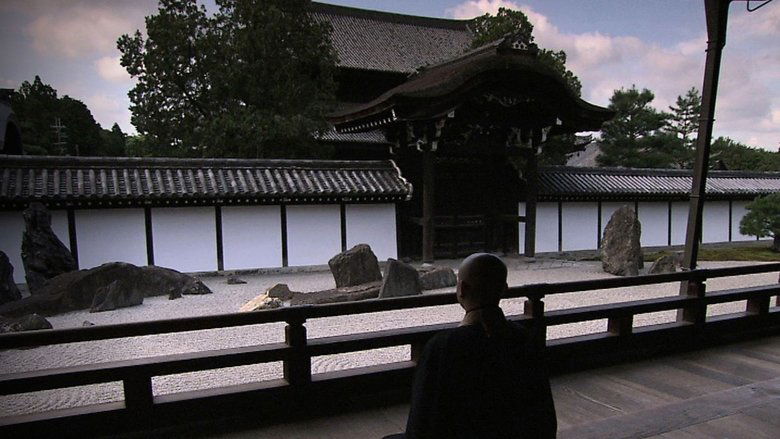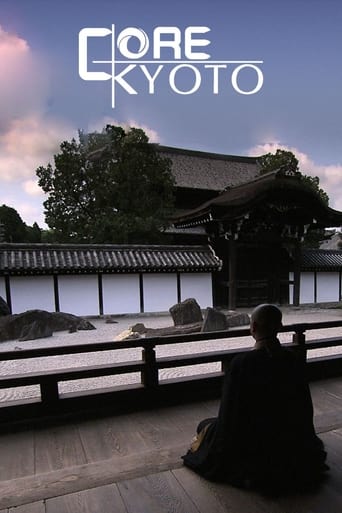
Trailer
Synopsis
The timeless heart of Japan's ancient capital. Against its rich backdrop of culture and tradition, today's Kyoto continues to innovate and inspire.
Episode 20 : Iwakura Fire Festival: The Divine Spirit Returns
December. 15,2016

At 3 a.m. on October 22, two large pine torches over 10m long are lit to signal the start of the fire festival at Iwakura Jinja. Long ago, it was believed that demons were contained by a huge boulder in the area, after which both the shrine and the area are named. In the late 1100's the shrine was built and the deity was transferred there, but it returns to the boulder on the day of the festival. Discover this 500-year-old festival through the preparations of the residents of Iwakura.
Episode 19 : Yase Shamenchi Odori: A Dance of Gratitude
November. 17,2016

Boys dressed as maidens walk the streets at night wearing lanterns adorned with intricate, cut-paper designs on their heads. Girls perform a votive dance. This intriguing festival held in Yase, located at the foot of Mt. Hiei in Kyoto's northeast, dates back some 300 years when a Senior Councilor in the shogunate sided with the people of Yase in a land dispute, which occurred nearby. Discover the residents' enduring gratitude as they prepare to fete the Councilor, now revered as a deity.
Episode 18 : Fusuma Paintings: Artful Partitions Transform Space
November. 03,2016

Fusuma are uniquely Japanese fittings, dating back a millennium, that act as partitions, sliding doors and walls. Painting them can transform a room's ambience. Fusuma paintings have evolved in keeping with the times, space, and patrons and artists' tastes. In the 1500's, magnificent paintings became signs of the wealth and power of the samurai class. In temples, ink paintings conveyed Buddhist teachings. Discover how fusuma paintings have raised furniture to the level of art.
Episode 17 : The Cinema Capital: The Professionals Behind the Samurai Filming Industry
October. 20,2016

Camera crews are common sights in Kyoto's historic streets and peaceful rural areas. The first film screening in Japan was held here in 1897, and Kyoto became the cradle of the Japanese movie industry, giving birth to masterpieces. Studios attracted expert craftsmen who created the sword fighting scenes, wigs and props needed to give samurai dramas authenticity. Discover a facet of the ancient capital at Uzumasa, the heart of the local film industry, where culture and history take center stage.
Episode 16 : Stone Jizo: Neighborhood Guardians Watch Over Children
October. 06,2016

Some 10,000 stone Jizo Buddhist statues dot the streets of Kyoto. At the end of summer, children gather at the street corners where the statues stand for lively Jizo Bon festivities. This annual event, where people pray for the health and success of their children, is also an opportunity for neighborhoods to strengthen their ties. Discover a cornerstone of ordinary Kyoto citizen's faith through the small, charming Jizo statues that are an integral part of local life.
Episode 15 : Kiyomizu Rokubey: Tradition and Vision in Ceramics
September. 22,2016

The Kiyomizu Rokubey studio, one of Kyoto's leading potteries, was established 245 years ago. Led by the current Rokubey, the 8th generation to take the name, it continues to produce elegant yet practical ceramics. Rokubey VIII is also a leading ceramic artist making original art objects. Yakushi-ji in Nara, which holds superb Buddhist art works, commissioned him to create a piece that will retain its presence throughout time. Discover the work of Rokubey as he strives to fulfill this request.
Episode 14 : Atago Sennichi Mairi: Pilgrimage to the Guardian Against Fire
September. 01,2016
Paper talismans protecting against fire are common sights in Kyoto homes. People receive them at Atago Jinja, situated on top of a rugged mountain. The shrine holds Sennichi-mairi, or the 1,000-day pilgrimage, on the evening of July 31. Worshippers believe that if they make the grueling trek they have 1,000 days' worth of protection against fire-related disasters. Discover the deep faith in Atago as more than 10,000 Kyotoites undertake the pilgrimage with gratitude for the gifts fire bestows.
Episode 13 : Cool Customs: Beating the Summer Heat
August. 25,2016
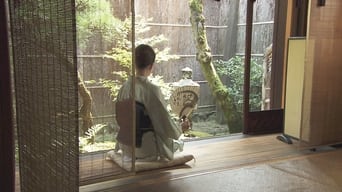
Kyoto is surrounded by mountains on 3 sides, so the city is concentrated in the basin where summers are sultry. Over the centuries, Kyotoites contrived ways to stay cool. They dread the heat but revel in the traditions. Come June, they prepare themselves physically and mentally by replacing the winter fittings, holding rituals for good health, and eating sweets that resemble ice. Discover the ingenuity and aesthetic beauty behind the customs Kyotoites observe to live in harmony with nature.
Episode 12 : Kata-yuzen: The Stenciled Beauty of Dyeing
July. 21,2016

Kata-yuzen is a Kyoto yuzen dyeing method that sometimes requires as many as 100 stencils to complete a bolt of kimono fabric. The development of this method saved dyers much time and enabled mass production. The most skill-intensive task is the carving of the washi paper to create the stencils. The elaborate designs and sharp lines that are difficult to attain by hand are captivating. Discover how the Kata-yuzen techniques were refined through the Kyotoites passionate pursuit of stunning kimono.
Episode 11 : Kyoto Walls: Elegance Molded from Earth
July. 07,2016

The ancient capital's dignified air of yesteryear is in part generated by earthen walls: the walls of the imperial palace, shrines, temples and even private properties. Earthen walls imbue tea houses with a rustic air. Kyoto is blessed with soil of a color ideal for these walls. Plasterers over centuries developed and refined their technique to produce walls befitting a capital. Discover the aesthetic sensibilities and expertise of traditional plasterers as they pursue beauty in earthen walls.
Episode 10 : Hidden Treasures: Preserved for Another Millennium
June. 16,2016
During the spring and fall tourist seasons Kyoto's shrines and temples open their usually hidden treasures to the public. The Buddhist statues and paintings, and other precious cultural assets that have survived centuries are threatened by degeneration, so special exhibitions are held to raise funds through entrance fees for repairing and preserving the objects. Discover Kyoto's fervor for preserving its cultural assets through the hidden treasures exhibited in Fushimi in spring 2016.
Episode 9 : Insho Domoto: The Pulsing Heart of Artistic Innovation
June. 02,2016

Kyoto artist Insho Domoto was prolific in the mid-20th century. He painted more than 600 dynamic sliding door paintings for Tofuku-ji, Chishaku-in and other major Buddhist temples in styles ranging from traditional Nihonga painting to innovative abstract painting. He has influenced a range of fields, such as sculpture, architecture, and the designs of traditional confectionery and accessories. Discover how "innovation is tradition" in Kyoto through works that reveal Domoto's creative spirit.
Episode 8 : Tsubo-niwa: Life Enhanced by Quintessential Spaces
May. 19,2016

Traditional Kyoto Machiya townhouses have narrow entrances, and are long and deep. At the back lie small Tsubo-niwa gardens, enclosed on all sides. Originally serving to light and ventilate the house, they enabled residents to comfortably endure the intense, summer heat. Over time, people applied their simple, austere aesthetic sensibilities to create beauty in these confined spaces. Discover the wisdom behind these gardens through the local lifestyle and the expertise of the landscape artists.
Episode 7 : Woodblock Prints: Beauty in the Hands of a Trinity of Artists
May. 05,2016

Traditional woodblock prints in the ancient capital have a strong, distinct history. Their origins lie in the woodblock printing of Buddhist scriptures. Compared to the mass production of ukiyo-e prints that were popular with Edo (now Tokyo) residents, woodblock printers in Kyoto were more focused on quality over quantity, creating delicate, soft expressions of art with their honed skills. Discover the subtle, elaborate beauty through the expertise of the three artists involved in process.
Episode 6 : Traditional Musical Instruments: Eternal Tones Waft Through the Ancient Capital
April. 21,2016

The world's oldest orchestral music, gagaku was imported from mainland China in ancient times. The melody is not based on a scale, yet the tunes are gentle, unmetered tones of continuous notes. The shakuhachi flute is a Buddhist instrument that brings enlightenment. The koto zither was much loved among the ancient aristocracy. The guitar-like shamisen entertains banquet guests in the flower districts. Discover the eternal tunes that harmonized the musical instruments' nature with human emotions.
Episode 5 : Obi: Unbridled Beauty in a Knot
April. 07,2016

The obi sash is an integral accessory for the kimono. One company has produced opulent Nishijin-ori obi for more than 120 years. A lady conveys the obi's allure through fitting classes. A dresser deftly ties the trailing obi of the Gion maiko. Fastened with a decorative cord, the obi is the final touch in a kimono ensemble. Its form manifests the obi's rich history and the sentiments of the people who produce or tie them. Discover the profound world hiding in a beautiful obi and its knot.
Episode 4 : Small Restaurants: A Full, Rich Experience While Sipping Sake
March. 03,2016

The streets of Kyoto are dotted with many cozy-looking restaurants, which some may feel awkward about entering. Many of these small restaurants, referred to as koryoriya, specialize in Japanese cuisine. The owner-chefs behind the counter, who take the orders personally, pride themselves on serving food that complements the drink, and vice versa. So koryoriya are places to enjoy good food, good drinks and good conversation. Discover the allure of Kyoto's food culture and how to enjoy koryoriya.
Episode 3 : Kyo-Kanoko Shibori: Untying the Beauty Bound Within
February. 18,2016

Kyo-kanoko shibori is the general term used for tie-dyed fabric made in Kyoto. The bumpy pattern on the fabric's surface is mesmerizing with its delicate shadows. Binding parts of the fabric to leave undyed areas allows certain colors to bleed and lends the design solidity. Each stage in the process has its own specialized artisan for design, binding, dyeing, and other stages in between. Discover the alluring world of Kyo-kanoko shibori through the dexterous hands of passionate artisans.
Episode 2 : Suiseki: A World of Understated Beauty Within Natural Stone
January. 21,2016

Suiseki is the appreciation of natural stone shapes using poetic imagination to visualize magnificent mountain, island, or waterfall landscapes. This pastime arrived from China in the late 1100's and spread among Kyoto aristocrats and Zen monks. Suiseki's beauty lies in the stones' understated simplicity and becalming quality. The Seven Stones of Kamo found in the Kamo River basin are prized in suiseki circles. Discover the profound world of rock appreciation that evolved in the old capital.
Episode 1 : Kyo-yaki: Kyoto Ceramics Charm and Delight the Beholder
January. 07,2016

Kyo-yaki, or artistic ceramics fired in Kyoto, evolved within the rich culture of the ancient capital as crockery for the local cuisine and as utensils in tea ceremony. One potter, who devotes his life to overglaze enamels, renders refined patterns and colors on his pieces. Another has refined his molding skills and creates pieces that are easy for chefs to use. These ceramics embody the Kyotoites' desire to please their guests. Discover how the charm of Kyo-yaki ceramics grows with use.
Seasons
Similar titles

Sahara with Michael Palin
In this four-part BBC documentary, former Monty Python funnyman and renowned globe-trotter Michael Palin sets off from Gibraltar to travel across the Sahara, his witty humor downplaying the hardships he faces along the arduous journey. He travels to Morocco, Mauritania, Mali and beyond, across some of the harshest terrain on the planet.
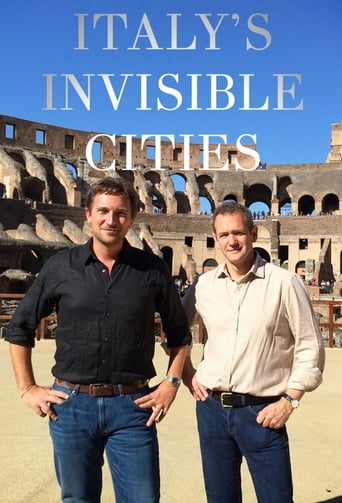
Italy's Invisible Cities
Using the latest 3D scanning technology, Alexander Armstrong and Dr Michael Scott uncover the hidden history of Italian civilisation and city life.

Seasoning the Seasons
This program visits places across Japan to introduce the charms of their local daily life and festivals fostered by the nation's long history.
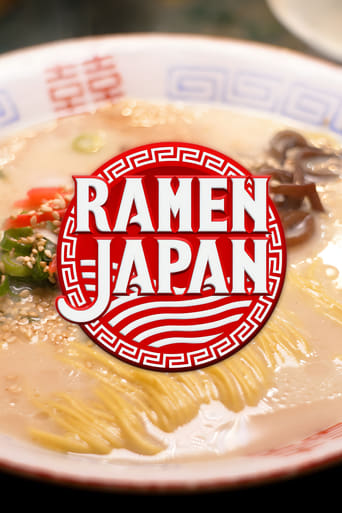
RAMEN JAPAN
Ramen is a savory combination of umami-packed broth and perfectly cooked noodles. This program offers an encyclopedic view of this delectable dish, taking you on a journey across Japan to discover ever-evolving local variations. Join us as we explore a tapestry of local customs and food culture through the lens of ramen.

Prime Video
Anthony Bourdain: Parts Unknown
Bourdain travels across the globe to uncover little-known areas of the world and celebrate diverse cultures by exploring food and dining rituals. Known for his curiosity, candor, and acerbic wit, Bourdain takes viewers off the beaten path of tourist destinations – including some war-torn parts of the world – and meets with a variety of local citizens to offer a window into their lifestyles, and occasionally communes with an internationally lauded chef on his journeys.

Jonathan Meades - Magnetic North
Jonathan Meades travels from the flatlands of Flanders to Germany's spectacular Baltic coast in an attempt to decipher exactly what northernness entails.

Jonathan Meades On France
Jonathan Meades scrutinises the 95 per cent of France that Brits drive through and don't notice en route to the 5 per cent that conforms to their expectation
Related

Postman Pat: Special Delivery Service
The world’s favourite Postman is back and delivering more than ever. Postman Pat has been promoted to the post of Head of Special Delivery Service. Equipped with his pilots license and a host of new transport options, Pat delivers in hard to reach places, from the top of a mountain to the middle of the sea anything from a giant ice block to a runaway cow!

Bloodline Detectives
Detectives and forensic experts recount the most extraordinary cold cases that were solved using the revolutionary technique of familial DNA testing.

The Enemies of Reason
The Enemies of Reason is a two-part television documentary, written and presented by evolutionary biologist Richard Dawkins, in which he seeks to expose "those areas of belief that exist without scientific proof, yet manage to hold the nation under their spell", including mediumship, acupuncture and psychokinesis.
The documentary was first broadcast on Channel 4 in the UK, styled as a loose successor to Dawkins' documentary of the previous year, The Root of All Evil?, as seen through the incorporation of brief clips from said documentary during the introduction of the first part by Dawkins. The first part aired 13 August 2007 and the second on 20 August 2007.
It includes interviews with Steve Fuller, Deepak Chopra, Satish Kumar, and Derren Brown.

Unspeakable
Welcome to the world of Unspeakable. Watch YouTube sensation Nathan Graham as he pulls pranks, competes in wild challenges with friends and collaborates with YouTube stars like Preston and ZHC.

DARK SIDE OF THE 2000S
This documentary series delves into the unseen histories of the 2000s decade, revealing dark secrets and personal insights from the people who witnessed all the train wrecks and triumphs first-hand.

Messy goes to OKIDO
OKIDO is a comedy adventure, science-educational series following a curious, adventure seeking and unruly monster called Messy as he finds the answers to everything a 3-5 year old child wants to know. Why do things fall down and not up? Where do echoes come from? Messy goes on incredible adventures with his two best friends, Zoe and Felix to find the answers. They are helped along the way by the bonkers science trio Zim, Zam and Zoom. Together they will fly to the moon, shrink to the size of atoms and fly on the back of a giant butterfly.
Top Streaming TV Show
#1

Ikaw
November. 12,2021
5.9
#2

Dexter: New Blood
November. 07,2021
8.1
#3

Money Heist
May. 02,2017
8.4
#4

Chicago Fire
October. 10,2012
8
#5

Emily in Paris
October. 02,2020
6.9
#6

The Witcher
December. 20,2019
8
#7

Yellowstone
June. 20,2018
8.7
#8

Squid Game
September. 17,2021
8
#9

The Bachelorette
September. 23,2015
5.3
#10

See
November. 01,2019
7.6
